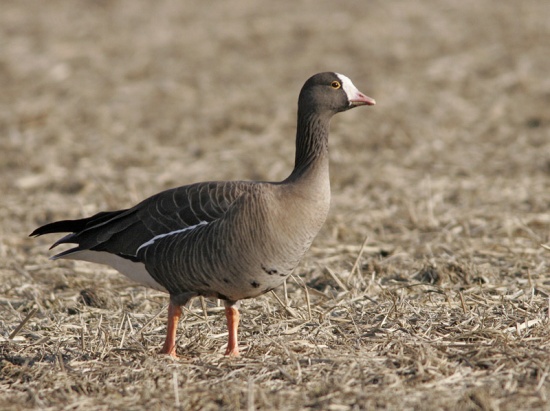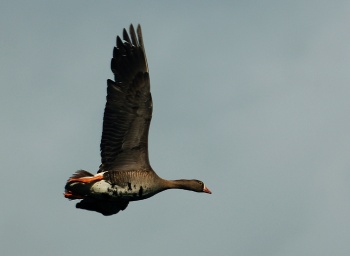- Anser erythropus
Identification
56–66 cm (22-26 in) length and with a 116–135 cm wingspan
- Bright orange legs
- Greyish-brown upper wing-coverts
- Yellow eye-ring
- White facial blaze goes up to the fore-crown
- Small pink triangular bill
- Black markings on belly
- Wing tips extend beyond tail
- In flight, tail shows narrow black and broad white band
- In flight, wings show a paler area in the hand that may flash silvery if the light is right
Similar Species
Generally smaller than the Greater White-fronted Goose, though there can be some overlap. Belly markings are more obvious on Greater. Distribution of black and white in the tail might be reversed on Greater.
Distribution
Breeds in arctic Eurasia; winters to southern Europe, India and China
Accidental on Attu Island, Alaska (1 record).
Taxonomy
This is a monotypic species[1].
Habitat
Breeds in low-arctic open tundra or forest-tundra around mountain lakes.
Behaviour
Diet
They are apparently mainly vegetarian, eating grass and other plants, but there is little confirmed data available.
Vocalisation
Call is more high-pitched than Greater
References
- Clements, J. F., T. S. Schulenberg, M. J. Iliff, D. Roberson, T. A. Fredericks, B. L. Sullivan, and C. L. Wood. 2018. The eBird/Clements checklist of birds of the world: v2018. Downloaded from http://www.birds.cornell.edu/clementschecklist/download/
- Collins Pocket Guide to British Birds 1966
- Collins Field Guide 5th Edition
- Collins Bird Guide ISBN 0 00 219728 6
- Birdforum thread discussing atypical Greater White-fronted Goose with features suggesting Lesser
- Handbook of the Birds of the World Alive (retrieved December 2016)
Recommended Citation
- BirdForum Opus contributors. (2025) Lesser White-fronted Goose. In: BirdForum, the forum for wild birds and birding. Retrieved 17 May 2025 from https://www.birdforum.net/opus/Lesser_White-fronted_Goose
External Links
GSearch checked for 2020 platform.1





